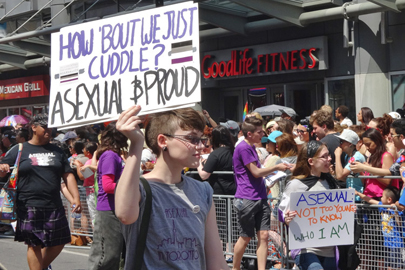How to Build a Three-Parent Family
David Jay is the oldest of 12 cousins on one side of his family and the third-oldest of 24 cousins on the other. As a kid, family to Jay meant having a lot of people around, a feeling of community, and crucially, a sense of permanence, that these people would always be in his life.
Later, as an adult living in collective housing, he could access the feeling of family with those around him, but the permanence was gone. His roommates started finding romantic partners, having children, and dispersing. Jay had always wanted his own family with kids—and had known, for almost as long, that he wouldn’t be able to build one the usual way.
Jay is the founder of the Asexual Visibility and Education Network and one of the most prominent people in the asexual movement. (Asexual people, or aces, don’t experience sexual attraction, though many do have sex and form romantic relationships.) After starting AVEN as a freshman at Wesleyan University in 2001, Jay spent years explaining asexuality to the public, speaking at events, and talking to the press. As he grew older, the questions on his mind moved beyond identity and attraction to issues of parenting and family life.
The problem for Jay was never how babies are made, and fostering and adoption were options. The problem was that he wanted kids and also wanted a co-parent to help him raise kids, but wasn’t interested in romantic partnership. Before exploring single parenthood, he was curious whether there might be another way to form the family he wanted.
Jay had already been forced to be creative in finding connection without romance. He remembers the first time he met someone with whom he had “really intense energy,” and how they took the time to explicitly discuss what their ideal relationship would look like. They didn’t want dating and sex. They wanted to go dancing together all the time and cook and meditate together. He’s now a godfather to her son.
Maybe, Jay thought, he could apply that creativity to the project of building a family—a permanent one—on his terms. Today, Jay is part of a three-parent family in northern California. He lives with a married couple, Avary Kent and Zeke Hausfather, and is not part of their marriage, but is a father to their biological daughter, Octavia, or Tavi, whose full name includes all three of their last names.
Jay is Tavi’s parent just as fully and permanently as Kent and Hausfather—and just as legally too, since three-parent adoption has been recognized by the state of California. (Three-parent adoption has also been recognized by state statute in Maine, Washington State, Rhode Island, and Vermont, according to Colleen Quinn, the director of the Adoption and Surrogacy Law Center at Locke & Quinn.) Family, in his own way.
Three-parent families are not a new phenomenon, and Jay doesn’t consider himself a trailblazer. Many parents, particularly those who are single or have low incomes, have long cobbled together child care by bringing relatives and friends in as informal co-parents, according to Philip N. Cohen, a sociologist of family at the University of Maryland. The idea that the default family unit consists of two straight parents and their children is outdated and doesn’t reflect the U.S. today. One 2014 Pew Research report, for example, found that fewer than half of American kids lived in a so-called traditional family environment, with two married parents on their first marriage.* Divorce and remarriage are more common than they once were, as are blended families and stepfamilies—many of which feature a third parental figure. The queer and polyamorous communities, too, have plenty of examples of three-parent families.
For Adams, tri-parenting is a way of reclaiming the “diversity and beauty of the queer community.” When it comes to queer rights, the big fight of past decades has been to legalize gay marriage, which has been significant, but has also played into the narrative that the two-parent family is and should be the default structure. “That has taken away some of the power of being able to live radically queer lives without needing to fit into a capitalist, patriarchal structure of a nuclear family,” Adams told me.
Jay’s family is one step removed from what a “traditional” three-parent structure looks like. It doesn’t have roots in assisted reproduction or even polyamory, but rather in ideas about relationships that Jay has been considering for most of his life, informed by his asexual identity.
More than a decade ago, Jay wrote his senior thesis on the question of what differentiates sexual relationships from nonsexual ones—besides, obviously, the sex—and why we treat them so differently. His conclusion, then and now, centers around permanence, or at least the expectation of it. “When a relationship becomes sexual and it becomes romantic, it’s not only that those things generate emotion, which they do,” he told me. “It’s that suddenly this relationship could be defining your entire future in a way that a friendship doesn’t have the same implied potential to be defining your future.”
The trio met one another’s families of origin. They worked through hard questions— What if someone finds a job elsewhere and wants to move? What if someone becomes seriously ill?—and wrote their answers down. They met with a mediator who told them about the option of third-parent adoption, and without hesitation, Kent and Hausfather said, “Yes, that’s what we want.”
On New Year’s Day in 2017, Kent found out she was pregnant. During her second trimester, Jay moved back to San Francisco. He attended birthing classes and was in the delivery room when Tavi was born that August.
Since then, Jay has been part of an alternative-parenting community in the Bay Area, where he sometimes introduces new acquaintances and friends to the idea of three-parent families.
One such friend is Kaitie. For as long as she can remember, the idea of being part of a two-parent family has seemed claustrophobic. The idea of a three-parent family had long interested her, but Jay was the first person whom she heard talk about it as a reality. (Kaitie asked to be identified by only her first name to protect her privacy.)
Kaitie just gave birth to a son. She became pregnant with someone who, initially, had been happy to be a romantic partner and a sperm provider but not a co-parent. Kaitie had planned to find two others to co-parent with, but then her partner decided that he wanted to raise the child after all, so the two are looking for a third co-parent to join them (though that’s been on hold because of the pandemic). That co-parent does not have to be romantically or sexually involved with either of them. “The idea of having to match romantically and sexually [while] co-parenting and cohabiting, it’s so much, you know?” Kaitie told me. “I don’t feel like I need to check all those boxes to find the perfect co-parent.”
Jay suspects that his being a platonic co-parent has led people to be much more accepting of his family structure than they would be if he were romantically or sexually involved with Kent and Hausfather. While their arrangement goes against the norm of a two-parent family, it doesn’t challenge the norm of two-person romantic relationships. “We sidestep all of the shaming and social scripts that would be [involved] in a poly three-parent family,” he told me. “There’s this whole universe of navigating implications about our sexual relationships that we just avoid entirely, and so that allows people to focus on the parenting and the benefit of the parenting.”
Similarly, Jay knows that his and his co-parents’ ability to champion this new form of family is tied to class and race. He, Kent, and Hausfather paid $5,000 total for the adoption process. All three are white, as is Kaitie, and as are most of Diana Adams’s tri-parenting clients.
Yet finding the right partners can be difficult no matter what. Katherine, who also knows Jay through the alternative-parenting community, wants to have a child and spent a few years looking for two fellow co-parents. (Katherine, who uses gender-neutral pronouns, also asked to be identified by their first name for privacy reasons.) Ideally, these would be people with whom Katherine had only a platonic relationship. “Sexual attraction can be very fickle; it’s not necessarily something that you want to base this lifelong familial commitment of raising children together on,” Katherine told me. Plus, Katherine is polyamorous, so their romantic and sexual needs were being met elsewhere, and their other partners weren’t interested in raising children.
It’s unclear how common third-parent adoption—in any of its incarnations—could become. Still, the increasing visibility and legalization of three-parent arrangements “is one of the signs that our definition of family is opening up,” Cohen, from the University of Maryland, told me.
For Jay, the arrangement has been smoother than expected. Having a third pair of hands (and a third income) to raise a child is easier. The division of parenting work in his family—carefully discussed and allotted during weekly logistics meetings—feels more fair than arrangements for many straight parents who are couples, who can easily fall into gendered assumptions of whose job it is to take care of the baby and who is only “helping out.” In Jay’s family, each of the three parents is less exhausted from taking care of Tavi, and that’s good for Tavi too, who gets to read and snuggle with Kent and play with blocks with Hausfather and take long walks in nature with Jay.
“All of our research points to the fact that it’s the quality of the relationships that matters, and the handling of communication and conflict, and the number of people in the household is not really the key,” says Pamela Braboy Jackson, an Indiana University sociologist and a co-author of How Families Matter: Simply Complicated Intersections of Race, Gender, and Work. “Just because family structure is different doesn’t mean that family operates any differently.” All families have rituals and stories about what makes their family theirs.
Tavi calls Hausfather “Daddy” and Jay “Dada.” She’s just getting to the age when she tries to play them against each other (“But Daddy said I could!”), though the adults have set up a text channel to make sure she can’t game them. She’s also surrounded by kids who don’t come from traditional two-parent families. The kid next door has two moms and a dad, for instance, so Tavi has realized that there are lots of kinds of families and her own is just one of many possible shapes.
Logistical benefits aside, Jay wants everyone to know that more options exist than people may believe. “If you’re someone like me, who really wants kids in my life and doesn’t want a primary romantic and sexual partner, then there are ways to do that,” he said. “If you are someone who wants a kid in your life but you really want a kid in your life once a week, not every day, for many hours a day, you can find a way to do that.” The important thing is that people look beyond the obvious next steps and believe in the ability to “choose your own family and choose your own path.”









Queers+ and more queers oh, hell was made for somebody😂😂😂😂😂